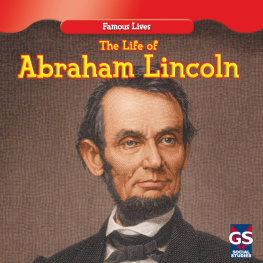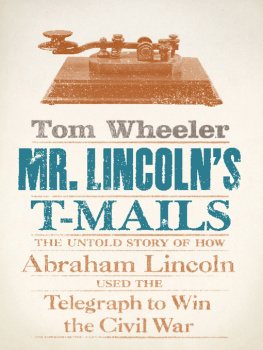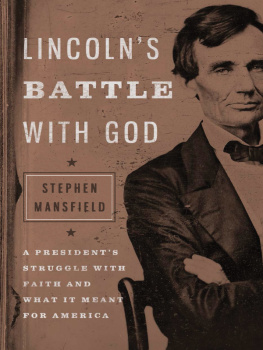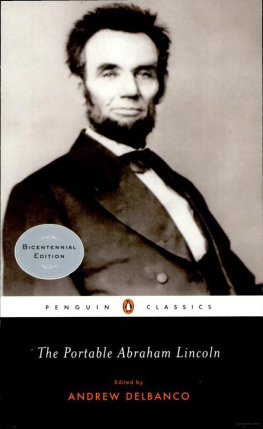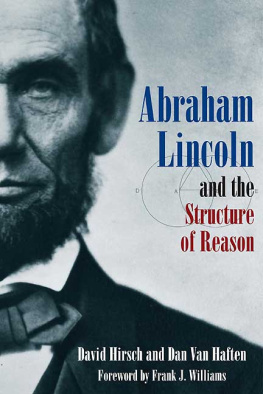David J. Kent is a Lincoln researcher and an award-winning career scientist. He is currently president of the Lincoln Group of the District of Columbia, treasurer and Executive Committee member of the Board of Directors of the Abraham Lincoln Institute, a member of the Board of Advisors of the Lincoln Forum, and an active member of the Abraham Lincoln Association. He is the author of several previous books on Abraham Lincoln, Nikola Tesla, and Thomas Edison, including Lincoln: The Man Who Saved America, which was nominated for multiple awards. He has written about Lincoln in Civil War Times, the Lincoln Herald, the Smithsonian Civil War Studies online newsletter, the Bulletin of the Lincoln Forum, and the Lincolnian. An avid reader, his Abraham Lincoln book collection exceeds 1,600 volumes, and he reads twenty to thirty new Lincoln books a year. His research focuses on Lincolns interests in science and technology. His website is http://www.davidjkent-writer.com/.
AS WITH ANY BOOK OF THIS NATURE, THE AUTHOR STANDS ON THE shoulders of every researcher who paved the way so that others may follow, especially those who have painstakingly compiled and edited many of the letters, documents, and primary materials that are the basis for all Lincoln research. I have been privileged to meet many of the most highly respected Lincoln scholars still living. From them I have gained insights, guidance, and encouragement for this and my previous books.
I begin by thanking Sidney Blumenthal for writing the foreword for this book. I first met Sidney at a symposium shortly before the first of his planned five-volume series on the political life of Abraham Lincoln was published. In the years since then, he has remained a giving and gracious source of information and support. And as readers can see in his foreword, he is a wonderful and insightful writer.
As I write this, I am president of the Lincoln Group of the District of Columbia, founded in the 1930s and perhaps the most active multi-faceted Lincoln organization in existence. Through monthly lectures and study forums, I have been privileged to know numerous colleagues and friends. While too many to list, here are a few who have been especially supportive: John OBrien, Jon Willen, Susan and Bernie Dennis, Wendy Swanson, Buzz Carnahan, Elizabeth Smith Brownstein, Catherine Lincoln, Rod Ross, Craig Howell, Debbie Jackson, Janet Saros, Rachel Riley, John Swallow, Jon Blackman, Diane Putney, Ted Beal, Dick Meyer, Ed Epstein, Richard Margolies, Carolyn Landry, Carl Adams, Scott Schroeder, Caroline Van Deusen, Carol Johnston, John Cooper, Matt Fink, Marida Amodio Mancino, Charlie Doty, Bob Willard, Dorothy DAntoni, and many others. I am forever indebted to the mentorship of the late John Elliff and the late Paul Pascal. Special thanks to Rod Ross for providing so many opportunities to help reach a greater audience.
I have also worked with a stellar group of scholars as a member of the board and current treasurer of the Abraham Lincoln Institute. I have gained insights from Michelle Krowl, Edna Greene Medford, Lucas Morel, Ron Soodalter, Terry Alford, Michael Burlingame, Stacy Pratt McDermott (Stacy Lynn), Jason Emerson, Tom Horrocks, Gordon Leidner, James Swanson, Paul Tetreault, and Jonathan White. Another group in which I am active, the Lincoln Forum, has provided access to and deep discussions with some of the leading Abraham Lincoln scholars in the world, including Harold Holzer, Frank Williams, Craig Symonds, Wendy Allen, Dan Weinberg, David Hirsch, and Dan Van Haften. On my trips to The Land of Lincoln (aka Illinois), I have been privileged to meet with some of the finest minds of the Abraham Lincoln Association, including Wayne Temple, Kathryn Harris, Bob Lenz, Guy Fraker, Richard Hart, Sarah Watson, Bob Willard, and Christian McWhirter.
Research libraries, museums, and papers collections are the backbone of historical research, and it would be criminal not to acknowledge the assistance of so many people over the years of research needed to prepare this book. Michelle Krowl at the Library of Congress and James Cornelius, formerly of the Abraham Lincoln Presidential Library and Museum, were especially helpful. Thanks to Emily Rapoza for giving me a tour of the vault and so much help finding pertinent files in their outstanding Lincoln Collection at the Allen County Public Library. My thanks also to Michael Lynch and Steven Wilson of the Abraham Lincoln Library and Museum in Harrogate, Tennessee, for hosting me on a visit, showing me some of the coolest parts of their collection, and giving me access to many Lincoln-related papers, especially those of John Worden, commander of the Union ironclad USS Monitor. Frank Smith at the African American Civil War Memorial and Museum in Washington, D.C., has provided stellar information on the United States Colored Troops.
The friendship and assistance given to me by a variety of smaller venues helped me immensely, so thank you to the four delightful women at the Rockport, Indiana, public library who helped me find the Lincoln Landing site memorial, and especially the Genealogy Department for giving me access to their Lincoln collection; the gentleman at the Lincoln Pioneer Village in Rockport for his attention during my visit; the Henry Ford Museum and Greenfield Village, especially the docent of the Logan County Court House and the many people who helped explain the mills; the reenactors in the Living Historical Farm at the Lincoln Boyhood National Memorial in Lincoln City, Indiana, who diligently explained everything from how to make candles from rendered hog fat to Thomas Lincolns skills as a carpenter; and the park rangers at the Abraham Lincoln Birthplace National Park, especially Park Ranger William Ozment for explaining how the log cabin was made.
It takes a lot of expertise to cover such a far-ranging book. I am grateful to all the experts who graciously gave me the benefit of their knowledge. I thank Marc Rothenberg, longtime director of the Papers of Joseph Henry project at the Smithsonian Institution, for our long discussion of the relationship between Joseph Henry and Abraham Lincoln and for reviewing an excerpt of that chapter. Douglas L. Wilson helped steer me to Herndons papers for the Vestiges of Creation book, not to mention his work with Rodney O. Davis to organize and annotate all the letters and interviews compiled by William Herndon shortly after Lincolns assassination. Thank you Dr. Jon Willen, a prolific reenactor of Civil War surgery, for his friendship and extensive medical knowledge of the time period; Larry West for his help in tracking down information on the history of photography during the period; Melissa Winn for her photography expertise; former congressman Jerry Weller and Howard Marks, the past and current presidents of the Illinois State Society, for their encouragement and insights; Steven Wilson for providing me with copies of Wayne Temples two-part Lincoln the Lecturer papers from the Lincoln Herald; Erin Carlson Mast and Curtis Harris for their support and tour at President Lincoln Cottage. I also thank Anna Gibson Holloway for insights on the Monitor and giving me contacts at the Hunley project; Narciso Gomez, who portrayed Gustav, John Ericssons assistant, at the Monitor Center at the Mariners Museum during my visit (along with additional information beyond the displays he sent me); and Karen Needles for her Lincoln Archives Digital Project documents and other resources. Thanks to Amanda Kirby and all the people of the Shenandoah Valley Agricultural Research and Extension Center who maintain the Cyrus McCormick Farm in Raphine, Virginia. After my visit, Amanda took the time to provide me with follow-up information that was useful for my research. Thank you to funeral director Jeffrey Jones for his insights into the art and science of embalming, past and present. Thank you to George Mason University Professor Christopher Hamner, who provided substantial insights into the technology of the Civil War and Lincolns strategic thinking.


